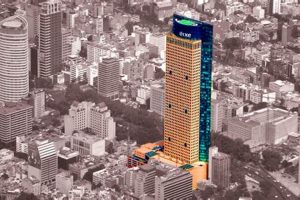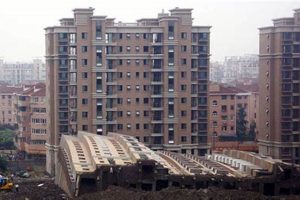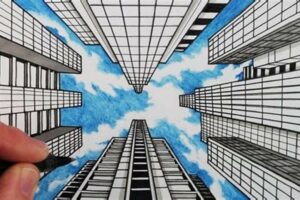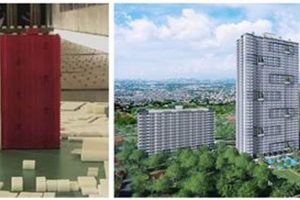Skyscrapers are among the world’s most impressive structures. They are architectural marvels that can house thousands of people and businesses. But how much do these towering structures cost to build?
The cost of a skyscraper can vary widely depending on a number of factors, including the size, height, location, and design of the building. However, some general estimates put the average cost of a skyscraper at around $300 million to $500 million.
Some of the most expensive skyscrapers in the world include the Burj Khalifa in Dubai, which cost an estimated $1.5 billion to build, and the One World Trade Center in New York City, which cost an estimated $3.8 billion to build.
1. Size
The size of a skyscraper is one of the most important factors that affects its cost. The larger the skyscraper, the more it will cost to build. This is because larger skyscrapers require more materials, labor, and time to build.
- Materials: Larger skyscrapers require more materials, such as steel, concrete, and glass. These materials can be expensive, especially if they are of high quality.
- Labor: Larger skyscrapers require more labor to build. This is because more workers are needed to erect the steel frame, pour the concrete, and install the glass. Labor costs can vary depending on the location of the skyscraper and the availability of skilled workers.
- Time: Larger skyscrapers take longer to build. This is because more time is needed to complete the various stages of construction. The longer it takes to build a skyscraper, the more it will cost.
In general, the cost of a skyscraper increases exponentially with its size. This means that a skyscraper that is twice as tall as another skyscraper will cost more than twice as much to build.
2. Height
The height of a skyscraper is another important factor that affects its cost. The taller the skyscraper, the more it will cost to build. This is because taller skyscrapers require more materials, labor, and time to build.
Here are some of the reasons why taller skyscrapers cost more to build:
- Materials: Taller skyscrapers require more materials, such as steel, concrete, and glass. These materials can be expensive, especially if they are of high quality.
- Labor: Taller skyscrapers require more labor to build. This is because more workers are needed to erect the steel frame, pour the concrete, and install the glass. Labor costs can vary depending on the location of the skyscraper and the availability of skilled workers.
- Time: Taller skyscrapers take longer to build. This is because more time is needed to complete the various stages of construction. The longer it takes to build a skyscraper, the more it will cost.
In general, the cost of a skyscraper increases exponentially with its height. This means that a skyscraper that is twice as tall as another skyscraper will cost more than twice as much to build.
The height of a skyscraper is also a major factor in determining its structural integrity. Taller skyscrapers are more susceptible to wind and seismic forces. This means that they require more robust structural systems, which can add to the cost of construction.
3. Location
The location of a skyscraper is a major factor that affects its cost. Skyscrapers built in major cities tend to be more expensive to build than those built in smaller cities or rural areas. This is because land costs are typically higher in major cities, and there is often more competition for skilled labor.
For example, the cost of building a skyscraper in New York City is typically much higher than the cost of building a skyscraper in a smaller city like Cleveland. This is because land costs in New York City are some of the highest in the world, and there is a high demand for skilled labor in the city.
In addition to land costs and labor costs, the location of a skyscraper can also affect its construction costs in other ways. For example, skyscrapers built in areas with strict environmental regulations may require more expensive materials and construction methods. Skyscrapers built in areas with a high risk of earthquakes or hurricanes may also require more robust structural systems, which can add to the cost of construction.
When considering the location of a skyscraper, it is important to weigh the costs and benefits of each location. While building a skyscraper in a major city may be more expensive, it may also be more profitable in the long run due to the higher demand for office space in major cities.
4. Design
The design of a skyscraper is a major factor that affects its cost. The more complex the design, the more it will cost to build. This is because complex designs require more materials, labor, and time to build.
For example, a skyscraper with a curved facade will cost more to build than a skyscraper with a flat facade. This is because curved facades require more complex engineering and construction methods. Similarly, a skyscraper with a lot of glass will cost more to build than a skyscraper with a lot of concrete. This is because glass is more expensive than concrete and requires more specialized installation methods.
In addition to the cost of materials and labor, the design of a skyscraper can also affect its construction timeline. Complex designs can take longer to build than simple designs. This is because complex designs require more coordination between different trades and more time to complete each stage of construction.
When considering the design of a skyscraper, it is important to weigh the costs and benefits of different design options. While a complex design may be more expensive to build, it may also be more visually appealing and attract more tenants. Ultimately, the best design for a skyscraper is the one that meets the needs of the owner and the budget.
5. Materials
The materials used to construct a skyscraper have a major impact on its cost. The type of materials used, the quality of the materials, and the quantity of materials all affect the overall cost of the building.
The most common materials used in skyscraper constru
ction are steel, concrete, and glass. Steel is used for the structural frame of the building, concrete is used for the floors and walls, and glass is used for the windows and exterior cladding. The quality of the materials used can also affect the cost of the building. Higher quality materials are more expensive, but they can also last longer and require less maintenance.
The quantity of materials used also affects the cost of the building. Larger skyscrapers require more materials than smaller skyscrapers. This is because larger skyscrapers have more floors, more walls, and more windows.
The cost of materials has a significant impact on the overall cost of a skyscraper. By carefully selecting the materials used, the quality of the materials, and the quantity of materials, it is possible to reduce the cost of a skyscraper without sacrificing quality or durability.
6. Labor costs
Labor costs are a major factor in determining how much a skyscraper costs to build. Skyscrapers are complex structures that require a large number of skilled workers to design, engineer, and construct. The cost of labor can vary depending on the location of the skyscraper, the availability of skilled workers, and the complexity of the design.
- Skilled labor: Skyscrapers require a variety of skilled workers to build, including architects, engineers, construction managers, and trade workers. The cost of skilled labor can be significant, especially in areas where there is a high demand for skilled workers.
- Unskilled labor: Skyscrapers also require a large number of unskilled workers to perform tasks such as cleaning, security, and maintenance. The cost of unskilled labor is typically lower than the cost of skilled labor, but it can still add up over the course of a large construction project.
- Location: The cost of labor can also vary depending on the location of the skyscraper. Labor costs are typically higher in large cities than in small towns or rural areas. This is because there is a greater demand for skilled workers in large cities, and the cost of living is typically higher in large cities.
- Complexity: The complexity of the design can also affect the cost of labor. Complex designs require more skilled workers and more time to complete, which can increase the cost of labor.
Labor costs are a significant factor in determining how much a skyscraper costs to build. By understanding the factors that affect labor costs, it is possible to minimize labor costs and build a skyscraper that is both cost-effective and high-quality.
7. Amenities
Amenities play a significant role in determining how much a skyscraper costs to build. The more amenities a skyscraper has, the more it will cost to build. This is because amenities require additional materials, labor, and time to install and maintain.
- Mechanical, electrical, and plumbing (MEP) systems
MEP systems are essential for the operation of any skyscraper. These systems include heating, ventilation, air conditioning, plumbing, electrical, and fire safety systems. The cost of MEP systems can vary depending on the size and complexity of the skyscraper.
- Elevators and escalators
Elevators and escalators are essential for moving people around a skyscraper. The cost of elevators and escalators can vary depending on the number of floors in the skyscraper and the type of equipment used.
- Security systems
Security systems are essential for protecting the people and property in a skyscraper. These systems can include security cameras, access control systems, and intrusion detection systems. The cost of security systems can vary depending on the size and complexity of the skyscraper.
- Other amenities
Other amenities that can add to the cost of a skyscraper include fitness centers, swimming pools, conference rooms, and retail space. The cost of these amenities can vary depending on the size and type of amenity.
When considering the cost of amenities, it is important to weigh the costs and benefits of each amenity. While some amenities may be essential for the operation of a skyscraper, others may be more discretionary. By carefully selecting the amenities that are included in a skyscraper, it is possible to reduce the cost of construction without sacrificing quality or functionality.
8. Timeline
The timeline of a skyscraper project is a major factor in determining its cost. The longer it takes to build a skyscraper, the more it will cost. This is because the cost of labor, materials, and financing all increase over time.
There are a number of factors that can affect the timeline of a skyscraper project, including:
- The size and complexity of the skyscraper
- The location of the skyscraper
- The availability of skilled labor
- The weather conditions
- The financing arrangements
In order to minimize the cost of a skyscraper project, it is important to carefully plan the timeline and to identify and mitigate potential delays.
For example, if a skyscraper is being built in an area with a history of bad weather, it is important to build in extra time for delays caused by storms or other weather events. Similarly, if a skyscraper is being built in a remote area, it is important to factor in the time it will take to transport materials and labor to the site.
By carefully planning the timeline and identifying potential delays, it is possible to minimize the cost of a skyscraper project and ensure that it is completed on time and within budget.
9. Permits
Permits are an essential part of the skyscraper construction process. They ensure that the building is safe and meets all applicable building codes. The cost of permits can vary depending on the size and complexity of the skyscraper, as well as the location of the project. In some cases, the cost of permits can account for up to 5% of the total cost of the project.
There are a number of different types of permits that are required for skyscraper construction. These include building permits, zoning permits, and environmental permits. Building permits are required to ensure that the building is structurally sound and meets all safety codes. Zoning permits are required to ensure that the building is in compliance with local zoning laws. Environmental permits are required to ensure that the building does not have a negative impact on the environment.
The process of obtaining permits can be complex and time-consuming. It is important to start the process early in the planning stage of the project. This will give you enough time to gather the necessary documentation and to work with the permitting authorities to ensure that your project meets all applicable requirements. Failing to obtain the proper permits can result in delays and additional costs.
FAQs on Sky
scraper Construction Costs
Skyscrapers are architectural marvels that can house thousands of people and businesses. But just how much do these towering structures cost to build? The answer is not a simple one, as the cost of a skyscraper can vary widely depending on a number of factors. This FAQ section addresses some of the most common questions about skyscraper construction costs.
Question 1: What are the major factors that affect the cost of a skyscraper?
The major factors that affect the cost of a skyscraper include its size, height, location, design, materials, labor costs, amenities, timeline, and permits. Each of these factors can have a significant impact on the overall cost of the project.Question 2: What is the average cost of a skyscraper?
The average cost of a skyscraper can vary widely depending on the factors mentioned above. However, some general estimates put the average cost of a skyscraper at around $300 million to $500 million.Question 3: What are some of the most expensive skyscrapers in the world?
Some of the most expensive skyscrapers in the world include the Burj Khalifa in Dubai, which cost an estimated $1.5 billion to build, and the One World Trade Center in New York City, which cost an estimated $3.8 billion to build.Question 4: How can I reduce the cost of building a skyscraper?
There are a number of ways to reduce the cost of building a skyscraper. Some of these include carefully planning the design of the building, using less expensive materials, and negotiating favorable construction contracts.Question 5: What are the benefits of building a skyscraper?
Skyscrapers offer a number of benefits, including increased office space, improved energy efficiency, and enhanced prestige. They can also be used to create landmarks and iconic symbols for cities.Question 6: What are the challenges of building a skyscraper?
Building a skyscraper is a complex and challenging undertaking. Some of the challenges include designing a structurally sound building, meeting all safety codes, and obtaining the necessary permits.
Ultimately, the cost of a skyscraper is a complex issue that depends on a number of factors. By understanding the key factors that affect the cost of a skyscraper, you can get a better idea of how much it will cost to build your own skyscraper.
These are just a few of the most common questions about skyscraper construction costs. For more information, please consult with a qualified architect or engineer.
Transition to the next article section: Skyscrapers are an important part of the modern urban landscape. They provide much-needed office space and can be used to create landmarks and iconic symbols for cities. However, building a skyscraper is a complex and challenging undertaking. By understanding the key factors that affect the cost of a skyscraper, you can get a better idea of how much it will cost to build your own skyscraper.
Tips for Saving Money on Skyscraper Construction Costs
Building a skyscraper is a major undertaking, and the costs can be significant. However, there are a number of ways to save money on skyscraper construction costs without sacrificing quality or safety.
Tip 1: Plan carefully. The more planning you do upfront, the less likely you are to encounter costly surprises down the road. This includes developing a detailed budget, hiring a qualified architect and engineer, and obtaining all necessary permits.
Tip 2: Use less expensive materials. There are a number of ways to reduce the cost of materials without sacrificing quality. For example, you can use concrete instead of steel for the structural frame, or use less expensive types of glass for the windows.
Tip 3: Negotiate favorable construction contracts. When negotiating with contractors, be sure to get multiple bids and compare prices. You should also negotiate a contract that includes clear payment terms and schedules.
Tip 4: Take advantage of tax breaks and incentives. Many cities and states offer tax breaks and other incentives for the construction of skyscrapers. Be sure to research these incentives and take advantage of any that are available to you.
Tip 5: Consider prefabrication. Prefabrication is the process of constructing building components off-site and then assembling them on-site. This can save time and money compared to traditional construction methods.
Tip 6: Use sustainable design principles. Sustainable design principles can help to reduce the operating costs of a skyscraper over its lifetime. This can lead to significant savings in the long run.
Tip 7: Be patient. Building a skyscraper is a complex and time-consuming process. It is important to be patient and to work closely with your architect, engineer, and contractor to ensure that the project is completed on time and within budget.
Tip 8: Get creative. There are always new and innovative ways to save money on skyscraper construction costs. Be creative and explore all of your options.
By following these tips, you can save money on skyscraper construction costs without sacrificing quality or safety. With careful planning and execution, you can build a beautiful and iconic skyscraper that will be a landmark for your city for years to come.
Summary of key takeaways or benefits:
- By following these tips, you can save money on skyscraper construction costs without sacrificing quality or safety.
- Skyscrapers are an important part of the modern urban landscape. They provide much-needed office space and can be used to create landmarks and iconic symbols for cities.
- Building a skyscraper is a complex and challenging undertaking, but it is also a rewarding one. By carefully planning and executing your project, you can build a beautiful and iconic skyscraper that will be a landmark for your city for years to come.
Transition to the article’s conclusion:
Skyscrapers are an important part of the modern urban landscape. They provide much-needed office space and can be used to create landmarks and iconic symbols for cities. However, building a skyscraper is a complex and challenging undertaking. By understanding the key factors that affect the cost of a skyscraper and by following the tips outlined in this article, you can get a better idea of how much it will cost to build your own skyscraper and how to save money without sacrificing quality or safety.
Conclusion
The cost of a skyscraper can vary widely depending on a number of factors, including its size, height, location, design, materials, labor costs, amenities, timeline, and permits. However, by understanding the key factors that affect the cost of a skyscraper, you can get a better idea of how much it will cost to build your own skyscraper.
Skyscrapers are an important part of the modern urban landscape. They provide much-needed office space and can be used to create landmarks and iconic symbols for cities. Building a skyscraper is a complex and challenging undertaking, but it is also a rewarding one. By carefully planning and executing your project, you can build a beautiful and iconic skyscraper that will be a landmark for your city for years to come.







